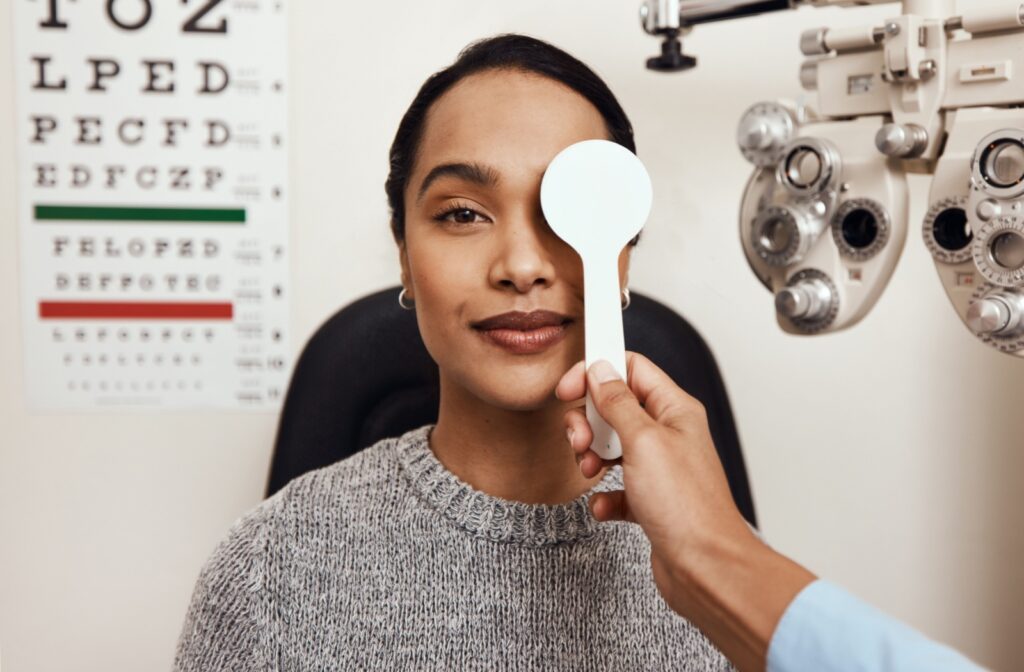Blurry vision is often caused by a group of conditions known as refractive errors. The most common of these are hyperopia (farsightedness), myopia (nearsightedness), and astigmatism. But what’s the difference?
Myopia causes blurry distance vision, hyperopia causes blurry near vision, and astigmatism creates blurry or distorted vision at any distance.
In this blog, we’ll compare these three vision conditions, explore what causes them, and discuss available treatment options to help you maintain healthy, clear sight.
What Is a Refractive Error?
To understand these three conditions, it’s helpful to know how the eye normally works. In a normal eye, light enters through the cornea and lens, bending (or refracting) to focus directly on the retina, the light-sensitive layer at the back of the eye. This creates a sharp image for your brain to interpret.
When the shape of your eye is irregular, whether this is due to the length of the eyeball or curvature of the cornea or lens, light doesn’t focus correctly on the retina. The result is what’s known as a refractive error, and it causes blurry or distorted vision. Myopia, hyperopia, and astigmatism are all examples of refractive errors, each with its own visual challenges and causes.
Myopia (Nearsightedness)
Myopia occurs when the eyeball is too long or the cornea is too curved. This irregular shape causes light to focus in front of the retina instead of directly on it. People with myopia see nearby objects clearly, but distant objects like road signs, whiteboards, or a faraway TV screen appear blurry.
Common symptoms of myopia include:
- Blurry distance vision
- Squinting to see clearly
- Frequent headaches
- Eyestrain or fatigue, especially during distance activities like driving
Myopia often begins in childhood and can worsen during adolescence as the eyes continue to grow. If left untreated, myopia may progress to high myopia, which increases the risk of developing serious eye conditions later in life, such as retinal detachment or glaucoma.
Hyperopia (Farsightedness)
Hyperopia is essentially the opposite of myopia. It occurs when the eyeball is too short or the cornea has too little curvature, causing light to focus behind the retina. This results in clear distance vision but blurry close-up vision.
People with hyperopia may struggle with tasks like reading, writing, or working on a computer, especially for long periods.
Common symptoms of hyperopia include:
- Blurry near vision
- Eye strain or discomfort while reading
- Headaches after close-up tasks
- Fatigue when doing up-close work
Mild hyperopia might go unnoticed, especially in younger people whose eyes can compensate by working harder to focus. However, this extra effort can cause symptoms over time if left uncorrected.
Astigmatism
Astigmatism occurs when the cornea or lens has an irregular shape. This irregularity scatters light as it enters the eye, causing it to focus in multiple places rather than directly on the retina.
Astigmatism often occurs alongside myopia or hyperopia, creating a more complex vision issue.
Common symptoms of astigmatism include:
- Blurred or distorted vision at all distances
- Trouble seeing clearly at night
- Eyestrain and headaches
- Frequent squinting
Astigmatism can develop naturally or result from eye injuries or surgeries. Some people are even born with it.
Diagnosis: Why Regular Eye Exams Matter
Whether you’re dealing with headaches, squinting, or simply can’t read road signs anymore, an eye exam is the best way to start trying to pinpoint the issue. Optometrists can use several tests to diagnose refractive errors, including:
- Visual acuity tests to assess clarity at different distances
- Refraction tests to determine the ideal lens prescription
- Corneal topography or keratometry to map the shape of the cornea (especially helpful in diagnosing astigmatism)
Even if you’re not noticing symptoms, early detection of these conditions can prevent future vision problems, especially in children and aging adults.

Treatment Options for Clearer Vision
Fortunately, all three of these refractive errors can be effectively corrected with the right treatment. Your eye doctor can recommend the best approach based on your prescription, lifestyle, and preferences.
1. Glasses
Eyeglasses are the most common and convenient solution. Depending on your needs, you might be prescribed single-vision lenses, bifocals, or progressive lenses.
2. Contact Lenses
Contacts offer clear vision and a wider field of view compared to glasses. Toric lenses are available for those with astigmatism, while daily disposables are a popular low-maintenance option.
3. Refractive Surgery
Procedures like LASIK and PRK can permanently reshape the cornea, correcting myopia, hyperopia, and astigmatism. These laser surgeries offer long-term vision correction, often reducing or eliminating the need for glasses or contacts.
Prevention & Eye Health Tips
While you can’t always prevent refractive errors, there are a few habits that can support eye health and reduce strain:
- Follow the 20-20-20 rule: Every 20 minutes, look at something 20 feet away for 20 seconds to ease digital eye strain.
- Eat for eye health: Leafy greens, colourful fruits, and foods rich in vitamins A, C, and E can nourish your eyes.
- Protect your eyes: Sunglasses with UV protection and proper safety eyewear can guard against damage.
- Prioritize routine eye exams: Staying proactive can help catch vision changes early and keep prescriptions up to date.
Take Control of Your Vision
Myopia, hyperopia, and astigmatism may differ in how they affect your sight, but they share one thing in common: they’re all manageable with the right care. If you’ve noticed changes in your vision, it’s time to schedule an eye exam and find out what’s really going on.
At Total Vision Sports Arena in San Diego, we’re here to diagnose and treat refractive errors with personalized solutions, whether that means glasses, contacts, or other vision correction options. Don’t wait for your vision to get worse. Book your appointment today and see the difference clearer sight can make.



